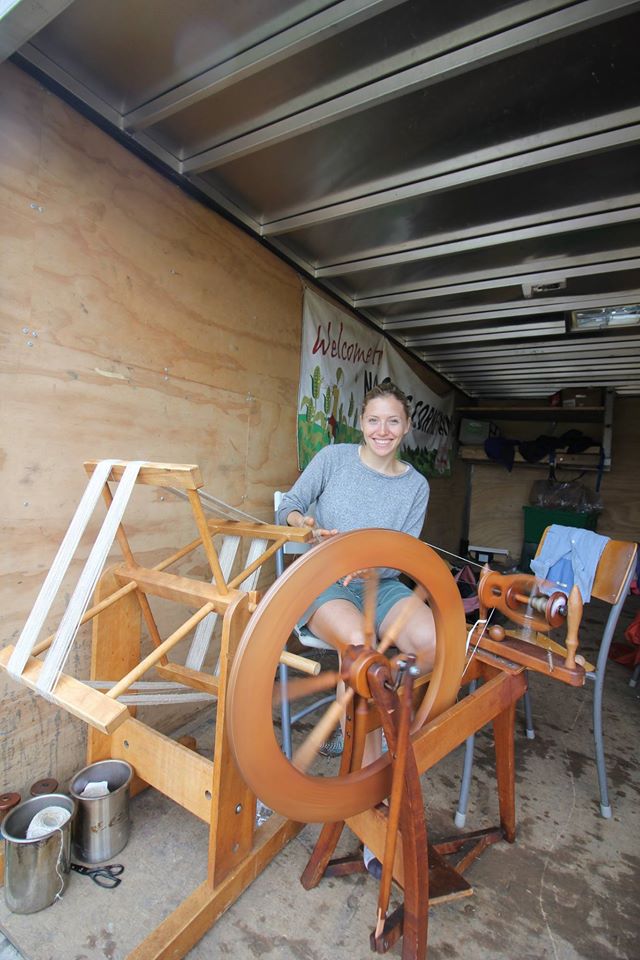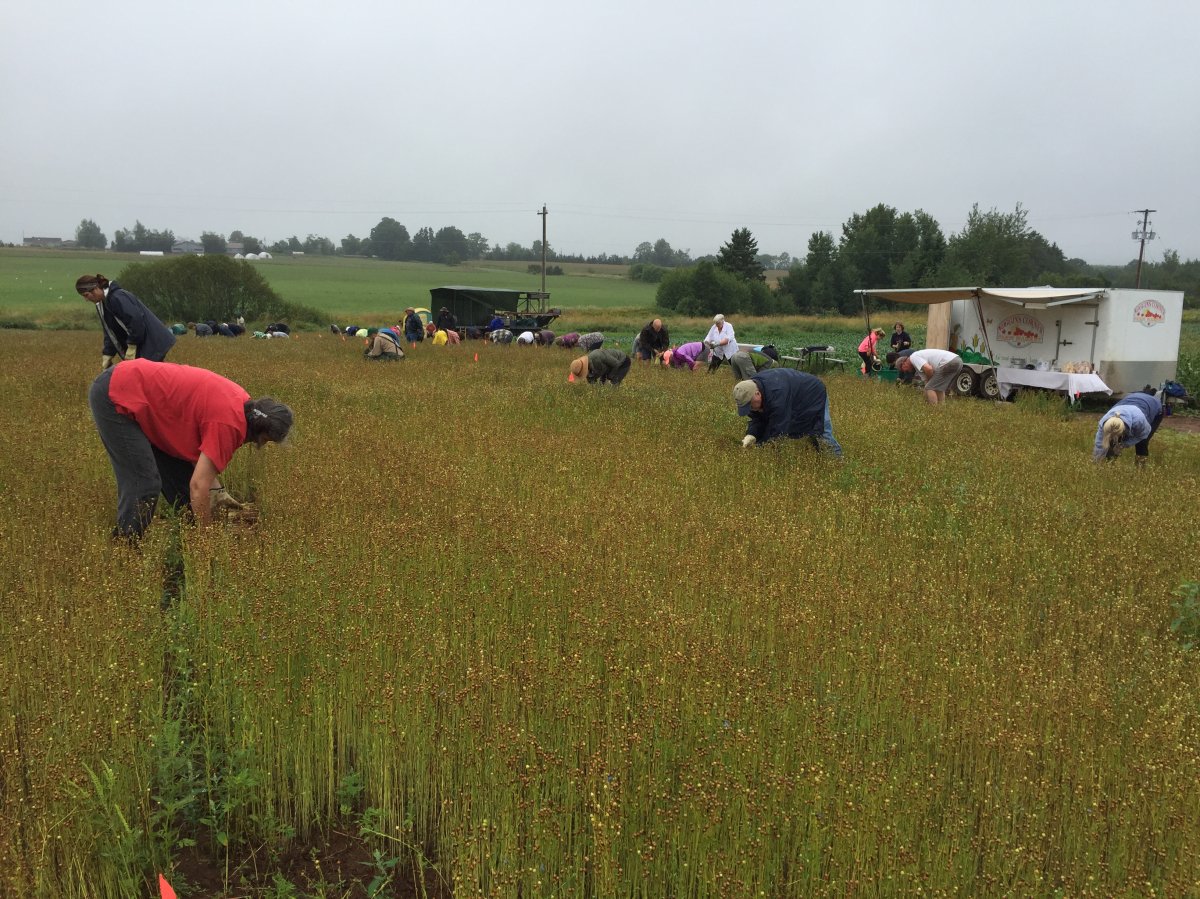A textile designer and weaver in Halifax, N.S., says people can begin to tell stories through their clothes again if they become in control of the designing process.

“Right now we purchase all of our clothing from overseas. We don’t have a say of the color palette or the material palette or the knit structure,” said Jennifer Green, an assistant professor at NSCAD University, also known as the Nova Scotia College of Art and Design.
“In the past, we were the creators of all of our clothing, and clothing was a really important vehicle through which we told stories about our land or our place or our cultures,” she added.
She’s set on bringing that tradition back through the use of the flax plant, which is used to make linen.
Launching a local natural fiber industry
Green is researching the history of flax, hemp and wool grown and processed in Nova Scotia with the goal of reviving and developing a local natural fiber industry in the province.
She says while Canada does not have a very prolific textile industry, many of the key components are attainable.
“Most of the clothing that we buy actually has a plant origin. So, for example, cotton comes from the cottonseed of the cotton plant and it gets spun or knit into the garments that we buy, and linen comes from the flax plant and wool comes from sheep,” said Green.
“So a lot of the materials we’re using have a plant or animal origin that we could create here.”
READ MORE: ‘We would slash the fabric’: Fashion’s harmful habit of destroying unsold clothes
But fast fashion is dominated by cotton and polyester, which have very heavy environmental footprints and that’s something Green wants to stay away from.
_848x480_1573731907973.jpg?w=1040&quality=70&strip=all)
The impact of fast fashion on the environment
A 2019 report stated that the environmental impact of the fashion industry is significant, with the apparel industry accounting for 10 per cent of global emissions.
According to the World’s Resources Institute in 2017, cotton is the most common natural fiber used to make clothing, but “it requires 2,700 liters of water — what one person drinks in two-and-a-half years — to make one cotton shirt.”

Get breaking National news
READ MORE: Environmental impacts of ‘fast fashion’ and what you can do as a consumer
Moreover, while synthetic fibers like polyester have less impact on water and land than grown materials like cotton, the institute said they emit more greenhouse gasses per kilogram.
“Polyester production for textiles released about 706 billion kg (1.5 trillion pounds) of greenhouse gases in 2015, the equivalent of 185 coal-fired power plants’ annual emissions,” the institute added.
‘We lost touch’
In 2012, Green partnered with TapRoot farms in Wolfville, N.S., to produce linen after she came across records of Nova Scotia and much of Eastern Canada having grown flax in the past.
“I was finding all these flax artifacts on people’s farms like old flax brakes that were around for a hundred years. And so I think I was just becoming really excited, like we can do this here.”
According to the Merriam-Webster dictionary, a flax brake is a machine for separating the woody stem tissues from the fiber in flax.
“We really lost touch with the significance of a localized economy and products that are grown in our region,” said Patricia Bishop, co-owner of TapRoot farms, adding we need to “celebrate the skills and talent within our region to bring a product from seed all the way through to a product or textile that we use.”
Bishop is also the co-owner of TapRoot Fibre Lab, which is responsible for creating long flax fibre processing equipment on a scale that can generate localized economic growth in rural and small communities.
The process of growing and processing flax
Both Green and Bishop have the same vision of starting a local textile industry in five or 10 years’ time, so they’re using their different skills to make it happen. TapRoot is responsible for growing the flax, while Green works to spin the fibre.
Bishop said growing and processing the flax is really labor intensive.
READ MORE: Canadians want more action on climate change, but are worried about ‘economic hardship’
“The first thing that happens is we prepare the soil, plant the seeds, and throughout the growing season of the flax plant, we need to keep the weeds away and make sure that the plant is healthy,” Bishop said.
Farmers would then wait for about 90 to 100 days to harvest the plant and the fiber.
“You pull the plant from the ground. And right now… we don’t have any flax pullers, the machinery kind. So all of the flax that’s being grown is pulled by hand.”
In order to create very fine yarn and product, Green said they’d have to develop machinery.
“There is knowledge that needs to be harnessed in order to produce the machinery and also funding that needs to be secured to develop that,” said Green.
Trying to make the process less expensive
The way TapRoot Fiber Lab is growing and processing the plant is very expensive, according to Bishop.
She says the cost for the yarn to make a simple washcloth at a workshop is $20 or more.
“We’re working at trying to make all of the steps in our process more efficient. The challenge with doing something new is that we don’t have large volume systems that we’re working with,” said Bishop.
READ MORE: Ethical clothing options still available for the mainstream shopper
“We’re doing really small batches, almost like testing. And so we need to get to the point where we have full time production in our facilities so that the cost is reduced,” she added.

In addition to running the lab and farm, Bishop also offers workshops on creating different pieces of garments using local fiber.
“It’s just important for me, for people, to be aware that it’s not only about choosing food that significant. It’s also fiber,” Bishop said, adding that the workshops are a way for people to get their hands on locally grown fiber.
READ MORE: Environment ministers set goal of cutting Canadian waste in half by 2040
It’s not just residents who are showing interest in using local fiber. Green said many students in NSCAD are interested in these processes and want sustainable fashion to become the norm.
Senior students at NSCAD got to visit the TapRoot Fiber Lab last summer year to speak with Bishop and check out the equipment. They’ve also worked on processing flax.
Bishop says if more people start thinking about and identifying with local fiber, that would have a huge impact on what they’re doing.
“If we turn towards local materials, we can really design our garments with our specific location in mind, whether that’s our specific climate or our specific unique cultural qualities here in Nova Scotia. All of those things can become part of what we associate with clothing again,” added Green.













Comments